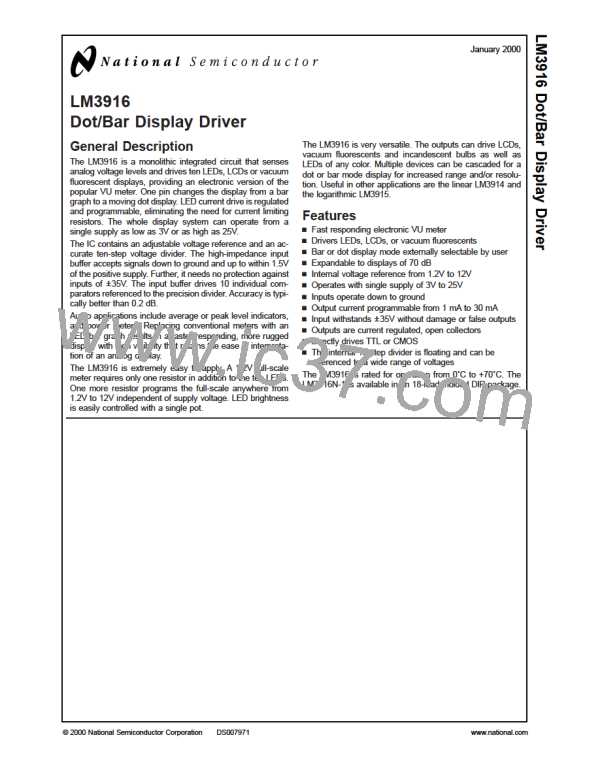Application Hints (Continued)
DS007971-14
Design Equations
GAIN
1
R5
100k 43k
1M
R6
C2
C3
2.0
0.56 µF
10
100k 1.0 0.056 µF
*
FIGURE 7. Full-Wave Average Detector to VU Meter Specifications
Cascading The LM3916
Peak Program Meter
The VU meter, originally intended for signals sent via tele-
phone lines, has shortcomings when used in high fidelity
systems. Due to its slow response time, a VU meter will not
accurately display transients that can saturate a magnetic
tape or drive an amplifier into clipping. The fast-attack peak
program meter (PPM) which does not have this problem is
becoming increasingly popular.
The LM3916 by itself covers the 23 dB range of the conven-
tional VU meter. To display signals of 40 dB or 70 dB dy-
namic range, the LM3916 may be cascaded with the 3 dB/
step LM3915s. Alternatively, two LM3916s may be cascaded
for increased resolution over a 28 dB range. Refer to the Ex-
tended Range VU Meter and High Resolution VU Meter in
the Typical Applications section for the complete circuits for
both dot and bar mode displays.
While several European organizations have specifications
for peak program meters, the German DIN specification
45406 is becoming a de facto standard. Rather than respond
instantaneously to peak, however, PPM specifications re-
quire a finite “integration time” so that only peaks wide
enough to be audible are displayed. DIN 45406 calls for a re-
sponse of 1 dB down from steady-state for a 10 ms tone
burst and 4 dB down for a 3 ms tone burst. These require-
ments are consistent with the other frequently encountered
spec of 2 dB down for a 5 ms burst and are met by an attack
time constant of 1.7 ms.
To obtain a display that makes sense when an LM3915 and
an LM3916 are cascaded, the −20 dB output from the
LM3916 is dropped. The full-scale display for the LM3915 is
set at 3 dB below the LM3916’s −10 dB output and the rest
of the thresholds continue the 3 dB/step spacing. A simple,
low cost approach is to set the reference voltage of the two
chips 16 dB apart as in Figure 5. The LM3915, with pin 8
grounded, runs at 1.25V full-scale. R1 and R2 set the
LM3916’s reference 16 dB higher or 7.89V. Variation in the
two on-chip references and resistor tolerance may cause a
±
1 dB error in the −10 dB to −13 dB transition. If this is ob-
The specified return time of 1.5s to −20 dB requires a
650 ms decay time constant. The full-wave peak detector of
Figure 6 satisfies both the attack and decay time criteria.
jectionable, R2 can be trimmed.
The drawback of the aforementioned approach is that the
#
threshold of LED 1 on the LM3915 is only 56 mV. Since
comparator offset voltage may be as high as 10 mV, large er-
rors can occur at the first few thresholds. A better approach,
as shown in Figure 9, is to keep the reference the same for
11
www.national.com

 NSC [ National Semiconductor ]
NSC [ National Semiconductor ]